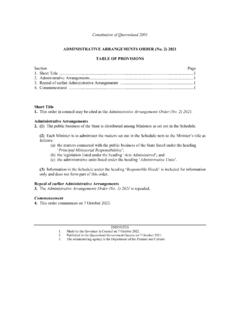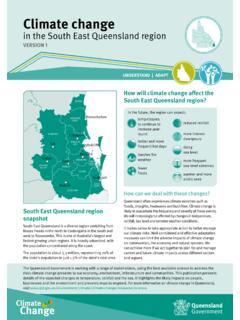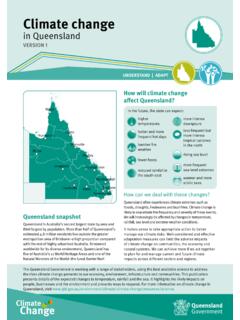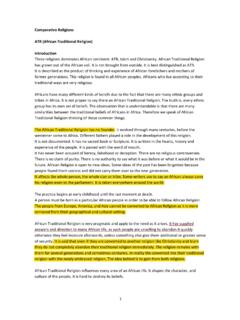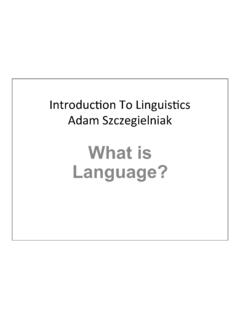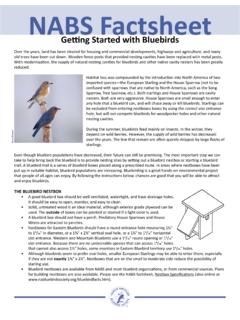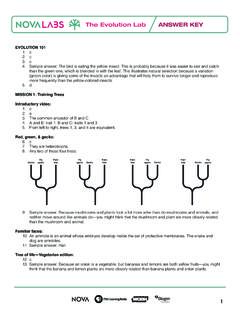Transcription of Collecting and preserving fungi specimens, a manual
1 Collecting and preserving fungi specimens, a manual Queensland Herbarium Department of Science, Information Technology and Innovation February 2017 version prepared by Megan Prance and Nigel Fechner Queensland Herbarium, Science Delivery Division Department of Science, Information Technology and Innovation PO Box 5078 Brisbane QLD 4001 The State of Queensland (Department of Science, Information Technology and Innovation) 2017 The Queensland Government supports and encourages the dissemination and exchange of its information. The copyright in this publication is licensed under a Creative Commons Attribution Australia (CC BY) licence Under this licence you are free, without having to seek permission from DSITI, to use this publication in accordance with the licence terms. You must keep intact the copyright notice and attribute the State of Queensland, Department of Science, Information Technology and Innovation as the source of the publication.
2 For more information on this licence visit Disclaimer This document has been prepared with all due diligence and care, based on the best available information at the time of publication. The department holds no responsibility for any errors or omissions within this document. Any decisions made by other parties based on this document are solely the responsibility of those parties. Information contained in this document is from a number of sources and, as such, does not necessarily represent government or departmental policy. If you need to access this document in a language other than English, please call the Translating and Interpreting Service (TIS National) on 131 450 and ask them to telephone Library Services on +61 7 3170 5725 Citation Prance, M. & Fechner, N. (2017). Collecting and preserving fungi specimens, a manual . 2nd edition. Department of Science, Information Technology and Innovation, Brisbane.
3 Acknowledgements This manual has been prepared by the Department of Science, Information Technology and Innovation. Acknowledgement is made of the Queensland Herbarium staff and Queensland Mycological Society members who have provided helpful comments. Ailsa Holland compiled the document. February 2017 Collecting and preserving fungi specimens i Contents introduction .. 1 fungi diversity in Australia 1 Why collect? .. 1 The Queensland Herbarium fungi collections 2 Before you collect .. 3 Permits and permission 3 Safety first 3 Safe travel procedures 4 When to collect 4 Standard Equipment for fungal fieldwork 4 Making a collection .. 5 Selecting the fruiting bodies 5 How many fruit bodies do I collect? 5 How to collect a fruit body 6 Storing specimens 7 Field notes .. 7 The key pieces of information to record 8 Photography .. 10 Photographing boletes 11 Making a spore print.
4 11 Writing a description .. 13 Drying specimens .. 13 Storing dried specimens 15 Submitting data, photographs and specimens .. 16 What happens to my specimens after they are submitted? 16 Final words of advice .. 17 References and Resources .. 17 Appendix 1: Description sheet and illustration chart .. 18 Department of Science, Information Technology and Innovation ii List of figures Figure 1 Total Queensland fungi collections (left) compared to total Queensland vascular plant collections (right) (Queensland Herbarium December 2016) .. 3 Figure 2 fungi Collecting tools (left) and truffle rake (right) .. 4 Figure 3 Examples of good fungi collections .. 5 Figure 4 Examples of inadequate collections .. 6 Figure 5 Examples of collections including the attachment points and a small amount of substrate. Trametes lactinea on the left and Laccocephalum sp. on the right (missing its sclerotium).
5 6 Figure 6 Example of fresh collections into a tackle box.. 7 Figure 7 Setting the geocode units on Google Earth (above). The GPS data appears at the bottom of the screen to the right (below). This may need to be switched on by selecting View and Status bar .. 9 Figure 8 Field photo (above) and lab photo (below). DIY light box for lab photos (right) .. 10 Figure 9 Examples of bolete structure and staining after cutting .. 11 Figure 10 Making a spore print with stem intact (left), add wet tissue paper (middle) and cover (right) .. 12 Figure 11 Spore print on paper (left), on a glass slide (right) .. 12 Figure 12 Agaric in situ (left) and, as a specimen with spore print (right) .. 12 Figure 13 Food dehydrator (left) with large fungi (top right) and ready for small fungi (bottom right). These can be bought for as little as $40 the only mandatory feature is some form of temperature regulator.
6 15 Collecting and preserving fungi specimens 1 introduction fungi are simple, filamentous organisms comprised of masses of thread-like hyphae which constitute the body (mycelium) of the fungus. Unlike plants, fungi do not contain chlorophyll and are therefore incapable of directly manufacturing their own organic compounds for energy. Most fungi are microscopic, but some (macrofungi) intermittently produce fruiting bodies (sporocarps) that are highly visible. These are commonly called mushrooms or toadstools . The fungi have been assigned to their own Kingdom, but mycologists often work alongside botanists in major herbaria, where macrofungi collections and associated data and information are housed. The methods of collection and study of fungi are somewhat similar to those used in botany, however there are many differences. The purpose of this manual is to assist amateur mycologists and others to make useful collections of fungi that meet herbarium standards and therefore contribute to the overall knowledge of our fungi flora.
7 Lichens are not included in this manual . For information on Collecting lichens, please contact the Queensland Herbarium. fungi diversity in Australia fungi are found on every continent and in almost every habitat. They are commonly found in forest and rainforest but can also be located in open paddocks, garden beds, beaches and even in arid zones. Colours vary from extremely vivid and bright to drab, dull tones, or even fluorescent. Some may only be millimetres high and wide, while others can be measured in decimetres. fungi that are commonly known as mushrooms belong to a group referred to as the agarics, or gilled fungi . Other categories of macrofungi include boletes, cup fungi , club fungi , coralloids, gasteromycetes (puffballs, earthstars, phalloid fungi , bird s nests), jellies, corticioids (paint fungi ) and polypores. Australia also possesses a large diversity of another distinct group of macrofungi, the sequestrate fungi (truffles), which produce their sporocarps underground.
8 These are not true gourmet truffles, but are often referred to as truffle-like . Australian sequestrate fungi are generally produced within the top 10 cm of the soil, or directly beneath the litter or humus and can often be detected close to the diggings of foraging mammals, some of which rely on these fungi as an essential food source. There are many new species of fungi yet to be discovered, and the role of fungi in ecosystem function is as yet only fundamentally understood. High quality specimens and data are needed as materials for research to improve our understanding of this important group of organisms. Why collect? In Queensland, most areas are still poorly collected compared with vascular plants (Figure 1), and a significant proportion of specimens you collect will probably represent new discoveries or new records. Citizen scientists and amateur mycologists play an important role in finding and Collecting fungi , and ultimately documenting Queensland s fungi flora.
9 These specimen collections form the basic biological materials for researchers to describe new species and study their relationships and evolution. New genetic techniques have increased the need for well-annotated and correctly identified specimens (the mycologist s role) to be stored in herbaria, and collected in sufficient quantities to allow limited destructive sampling. These specimens need to be processed and stored so that the DNA is preserved for future study. Department of Science, Information Technology and Innovation 2 Herbarium collections and associated label data provide: reference material for accurate identification. basic biological material for taxonomists and other researchers to study. the core material upon which application of scientific names is based (Type specimens). a permanent record for a species at a particular time and location.
10 Reliable distribution maps and habitat information. vouchers for scientific research, including taxonomic, ecological and biochemical analyses and DNA sequences. information for production of fungal inventories for your local area. information for monitoring changes in composition and behaviour over time. reference material for recognition of those fungi species which are most appropriate for use in localised revegetation programs. data for monitoring programs which document the introduction and spread of invasive alien species. People with an interest in fungi are encouraged to submit good quality collections accompanied by useful field notes, descriptions and photographs. Submitted specimens are assessed according to the amount and condition of material and the quality of associated notes and photographs. The Queensland Herbarium currently has a particular interest in corals, boletes, phalloides, bird s nests and Fungimap targets These fungi are the subject of active research by Queensland Mycologists.




